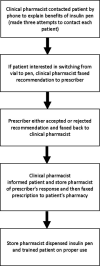Vial-to-Pen: Community-Based Pharmacists Converting Insulin Regimens
- PMID: 34007561
- PMCID: PMC8127085
- DOI: 10.24926/iip.v10i3.939
Vial-to-Pen: Community-Based Pharmacists Converting Insulin Regimens
Abstract
Objective: To describe a vial-to-pen conversion program driven by community-based pharmacists and determine conversion success rate.
Methods: A report based on prescription claims was generated and identified 200 prescriptions filled for an insulin vial product and syringes. Patients were contacted by community-based pharmacists during a five-month period and were informed of the availability and potential benefits of insulin pen delivery systems (IPDS). If the patient agreed to the switch, the pharmacist contacted the prescriber to obtain a new prescription. Prescription refill records were tracked for six months post-intervention to determine whether patients who were converted remained on the IPDS.
Results: The overall vial-to-pen conversion success rate was 26% out of 121 potential conversions. In addition, 52% of patients reached were willing to switch and prescribers approved 71% of the recommendations to switch from vial-to-pen. Of the prescriptions successfully converted to an IPDS, 84% of prescriptions were still dispensed as pen products six months following the conversion.
Conclusion: Community-based pharmacists can serve as a resource to provide education on insulin delivery options and increase use of IPDS in patients with diabetes.
Keywords: community pharmacy; insulin administration; insulin pen delivery systems; insulin syringe; insulin vial.
© Individual authors.
Figures
References
-
- National diabetes statistics report, 2014: estimates of diabetes and its burden in the United States Centers for Disease Control and Prevention website. [May 15;2015 ]. [Jun 17;2019 ]. http://www.cdc.gov/diabetes/pdfs/data/2014-report-estimates-of-diabetes-... Updated. Accessed.
-
- Coscelli C, Calabrese G, Pisu E, et al. Use of premixed insulin among the elderly. Diabetes Care. 1992;15(11):1628–30. - PubMed
-
- Rubin RR, Peyrot MP. Quality of life, treatment satisfaction, and treatment preference associated with use of a pen device delivering a premixed 70/30 insulin aspart suspension (aspart protamine suspension/soluble aspart) versus alternative treatment strategies. Diabetes Care. 2004;27(10):2495–97. - PubMed
-
- Lee WC, Balu S, Cobden D, Joshi AV, Pashos CL. Medication adherence and the associated health-economic impact among patients with type 2 diabetes mellitus converting to insulin pen therapy: an analysis of third-party managed care claims data. Clin Ther. 2006;28(10):1712–25. - PubMed
LinkOut - more resources
Full Text Sources


